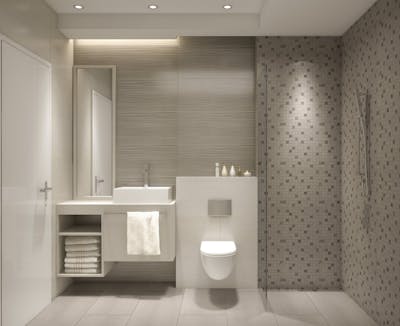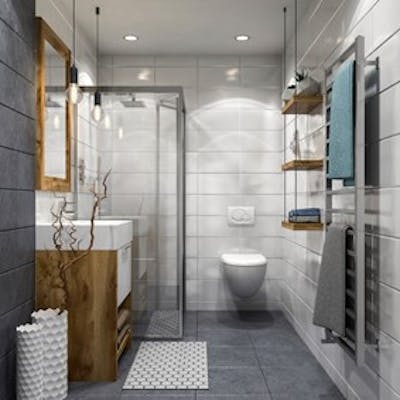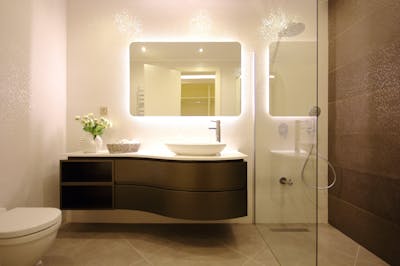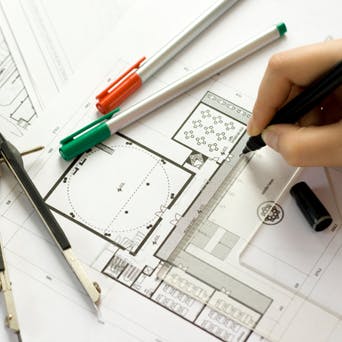Wet Room Design Tips And Ideas | More Bathrooms
Published: 28 October 2019
Designing The Perfect Wet Room
Wet rooms are growing in popularity, and rightly so - they’re a great way to maximise your space and add atouch of luxury to your home.
We know from experience that there are a huge range of designs for wet rooms available, depending on size, budget and personal style preferences.
We’re going to take a look at five key areas which you should consider when installing or renovating a wet room:
> The layout of the wet room
> Wall cover options
> Sanitaryware options
> Lighting ideas
> Different colour schemes
.jpg?auto=compress%2Cformat&cs=strip&ixlib=php-1.1.0&s=35a0d428e2e39b86bf583a1462975b0b)
1) Wet room designs – choosing your layout
The layout of your wet room is heavily dependent on where the waste pipe is positioned, as this’ll dictate where your sanitaryware can be placed. The location of your shower is also determined by the shape and size of the room you have to work with.
Practicality is of utmost importance, and you need to ensure that water can’t reach any doors or areas where non-waterproof items such as toilet paper are kept.
Design Top Tip
If you’re in search of or looking for how to make a small wet room or small en-suite wet room work, we recommend adding a glass screen to your shower area. This will help prevent water splashing around your wet room, without taking away from its open design.
To Find out more about wet room layouts and installation view our complete guide to wet room installation
2) Wall cover options for wet rooms
The wall coverings you choose can really make a difference to the look and feel of your chosen wet room design. There’s a wide variety of wall cover options available, but the most popular are tiles and wall boards.
Bathroom tile options include:
> Ceramic tiles – Made with a clay compound or silicate mixture and available in a wide choice of sizes and colours, ceramic tiles are a popular choice. They’re a budget-friendly option for a wide range of wet rooms.
> Marble tiles – Made from natural stone and available in a range of tones, sizes and finishes. Marble tiles are the perfect choice if you want to add some luxury and texture to your wet room.
> Glass tiles – Used for wall backsplashes and mosaic designs. Glass tiles can help to add depth to wet room designs.They also reflect light around the room, making your suite feel bigger in size.

Wall board options include:
> Solid core wall boards – These are commonly constructed from MDF (Medium Density Fibre Boards) or plywood. Solid core wall boards are available in mixture of colours and finishes, so can add personality and dimension to wet room designs.
> Acrylic wall boards – a cheaper alternative to glass tiles, acrylic wall boards are high gloss boards that provide a similar shine to glass. They help to bounce light around smaller wet room designs.
> UPVC wall boards – unplasticised poly vinyl chloride boards are known for being really durable and hard-wearing. They are a low maintenance option and easy to clean.
Design Top Tip
Always keep your budget in mind. The entire wall and floor
must be covered in your wet room to help to ensure it is waterproof, so choosing
a covering that has a high cost per unit can make your overall fit-out cost
expensive.
3) Sanitaryware options for your wet room
There’s a wide variety of sanitaryware available for wet rooms.If you have a small wet room, short projection toilets and small basins can help to free up central floor space, giving the illusion that your suite is larger in size.
Can a wet room have a bath?
The answer is yes - if you have the available space. There’s a range of bath sizes available, including straight, corner and space-saving bathtubs. Adding a free-standing bathtub to a large wet room can create a stunning focal point.
Design Top Tip
If you require inspiration for a small bathroom or are renovating a secondary suite, consider creating a wet room that consists of only a shower. This is a great way to maximise the use of available space.
.jpg?auto=compress%2Cformat&cs=strip&ixlib=php-1.1.0&s=afdb35046eb0aef1ced360d19d500406)
4) Lighting options
Choosing the best lighting for your wet room can be tricky if you’re not sure where to begin. Start with reviewing how much natural light windows are providing, then consider the mood you want to set in your wet room.
The options for bathroom lighting include:
> Ceiling lights – Used to create general illumination. Recessed lighting - where lights are installed into hollow openings within the ceiling - is a popular choice in wet rooms
> Downlights – Provide a good level of ambient lighting and can be used to enhance statement features within a bathroom. Place them around the sides as opposed to the centre of your room to help to avoid shadows.
> Task Lighting – Used to illuminate areas that are needed to perform a specific task, most commonly used at either side of a mirror. Consider task lighting if you use your wet room to apply makeup or shave.
Design Top Tip
Layer different lighting options to enhance the flexibility of your wet room. Regardless of size, a combination of lighting options, including dimmers, allows you to match the lighting with your mood.
5) Colour Schemes for your wet room
Choosing the right colour scheme is crucial in setting the mood and tone of your showering space.
Here’s a few ideas you can consider:
> Including bright colours and patterned feature walls is a great way to add personality to a wet room design. Consider yellows, oranges and greens as they can help to brighten your space and boost your mood.
> Light colours, including creams and beiges, add warmth whilst softening the overall feel.Consider light colours in your wet room if you wish to create a relaxing sanctuary.
> Minimal wet room designs including white, greys and monochrome colours create sophisticated simplicity. White alongside other light colours can help smaller rooms feel bigger.
> Including gold accents to finishing touches adds glamour to wet rooms.

Design Top Tip
Dare to be different. Some of the most stunning wet rooms
are those that have a unique touch. Quirky designs are a great way to transform
your suite into a statement room, perfect for impressing your guests.
To gather more information on wet room ideas and to see if your current showering space can be transformed into a wet room, book your free no obligation design appointment with one of our experienced designers.
Share this Post


.jpg?auto=compress%2Cformat&cs=strip&ixlib=php-1.1.0&s=35a0d428e2e39b86bf583a1462975b0b)

.jpg?auto=compress%2Cformat&cs=strip&ixlib=php-1.1.0&s=afdb35046eb0aef1ced360d19d500406)





















